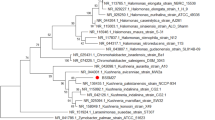Abstract
Saline and alkaline soils are major problems contributing to the low productivity of common bean (Phaseolus vulgaris) in arid and semi-arid regions such as Egypt. Therefore our study was directed toward selecting strains more tolerant to these environmental stresses. Among seven Rhizobium etli strains isolated from Egyptian soils, we found a high degree of diversity. Strains EBRI 21 and EBRI 26 are highly tolerant to a salt concentration up to 4% NaCl. A positive correlation was found between the salt tolerance and the adaptation to alkaline pH (9). Strains EBRI 2 and EBRI 26 were adapted to elevated temperatures (42°C). The minimum level of low pH for the majority of Rhizobium etli strains from Egypt was pH 4.7 while the Colombian strain Rhizobium tropici CIAT 899 survived well at pH 4. At 0.4% NaCl, the symbiotic efficiency of the salt-tolerant strain EBRI 26 was superior in cultivar Giza 6 compared with the salt-sensitive strain EBRI 2 (18.2 compared with 13.9 nM C2H4 h−1 mg−1 nodule fresh weight). In the bean cultivar Saxa, nitrogen fixation was much more affected by high salt concentration (0.4% NaCl) than in the cultivar Giza 6 with both strains (3.9 and 3.8 nM C2H4 h−1 mg−1 nodule fresh weight, respectively). In general, stress of alkalinity had a less detrimental effect on nodulation and N2 fixation than stress of salinity.




Similar content being viewed by others
Literature Cited
N Amarger V Macheret G Laguerre (1997) ArticleTitleRhizobium gallicum sp. nov. and Rhizobium giardinii sp. nov., from Phaseolus vulgaris nodules Int J Syst Bacteriol 47 996–1006
GL Bender BG Rolfe (1985) ArticleTitleA rapid assay for the Parasponia–Rhizobiumsymbiosis Plant Sci Lett 38 135–140
DPM Cordovilla F Ligero C Lluch (1999) ArticleTitleEffect of salinity on growth, nodulation and nitrogen assimilation in nodules of faba bean (Vicia faba L.) Appl Soil Ecol 11 1–7
EAE Elsheikh M Wood (1995) ArticleTitleNodulation and N2 fixation by soybean inoculated with salt-tolerant rhizobia or salt-sensitive bradyrhizobia in saline soil Soil Biol Biochem 27 657–661
J Evans Z Hochman GE O’Connor J Osborne (1988) ArticleTitleSoil acidity and Rhizobium: Their effect on nodulation of subterranean clover on the slopes of southern New South Wales Aust J Agric Res 38 605–618
PH Graham CA Parker (1964) ArticleTitleDiagnostic features in the characterization of the root nodule bacteria of legumes Plant Soil 20 383–396
NK Karanja M Wood (1988) ArticleTitleSelecting Rhizobium phaseoli strains for use with beans (Phaseolus vulgaris L.) in Kenya: Infectiveness and tolerance of acidity and aluminium Plant Soil 112 7–13
S Kulkarni S Surange SC Nautiyal (2000) ArticleTitleCrossing the limits of Rhizobium existence in extreme conditions Curr Microbiol 41 402–409
H Moawad DP Beck (1991) ArticleTitleSome characteristics of Rhizobium leguminosarum isolates from un-inoculated field-grown Lentil Soil Biol Biochem 23 933–937
J Nogales R Campos H Ben Abdelkhalek J Olivares C Lluch J Sanjuan (2002) ArticleTitleRhizobium tropici genes involved in free-living salt tolerance are required for the establishment of efficient nitrogen-fixing symbiosis with Phaseolus vulgaris Mol Plant–Microbe Interact 15 225–232
MI Piha DN Munns (1987) ArticleTitleSensitivity of the common bean (Phaseolus vulgaris L.) symbiosis to high soil temperature Plant Soil 98 183–194
UB Priefer J Aurag B Boesten I Bouhmouch R Defez A Filali-Maltouf M Miklis H Moawad B Mouhsine J Prell A Schlüter B Senatore (2001) ArticleTitleCharacterization of Phaseolus symbionts isolated from Mediterranean soils and analysis of genetic factors related to pH tolerance J Biotechnol 91 223–236
K Saadallah JJ Drevon M Hajji C Abdelly (2001) ArticleTitleGenotypic variability for tolerance to salinity of N2-fixing common bean (Phaseolus vulgaris) Agron J 21 675–682
P Somasegaran HJ Hoben (1985) Hand book for rhizobia: Methods in legume Rhizobium technology Springer Berlin Heidelberg New York
HL Steele P Vinuesa D Werner (2003) ArticleTitleA leucine biosynthesis mutant of Rhizobium tropici CIAT 899 which survives at pH 3.5 Biol Fertil Soils 38 84–88
S Surange AG Wollum N Kumar CS Nautiyal (1997) ArticleTitleCharacterization of Rhizobium from root nodules of leguminous trees growing in alkaline soils Can J Microbiol 43 891–894
P Vinuesa F Neuman-Silkow C Pacios-Bras HP Spaink E Martinez-Romero D Werner (2003) ArticleTitleGenetic analysis of a pH-regulated operon from Rhizobium tropici CIAT 899 involved in acid tolerance and nodulation competitiveness Mol Plant-Microbe Interact 16 159–168
P Vinuesa JLW Rademaker FJ Bruijn Particlede D Werner (1998) ArticleTitleGenotypic characterization of Bradyrhizobium strains nodulating endemic woody legumes of the Canary Islands by PCR restriction fragment length polymorphism analysis of genes coding 16S rDNA and 16S–23S rDNA intergenic spacers, repetitive extragenic palindromic, PCR genomic finger printing and partial 16S rDNA sequencing Appl Environ Microbiol 64 2096–2104
D Werner JK Wilcockson E Zimmerman (1975) ArticleTitleAdsorption and selection of rhizobia by ion exchange papers Arch Microbiol 105 27–32
HH Zahran (1999) ArticleTitleRhizobium–legume symbiosis and nitrogen fixation under severe conditions and in an arid climate Microbiol Mol Biol Rev 63 968–989
Acknowledgment
We thank the EU for support by INCO-DEV-ICA4-CT-2001-10057.
Author information
Authors and Affiliations
Corresponding author
Rights and permissions
About this article
Cite this article
Shamseldin, A., Werner, D. High Salt and High pH Tolerance of New Isolated Rhizobium etli Strains from Egyptian Soils. Curr Microbiol 50, 11–16 (2005). https://doi.org/10.1007/s00284-004-4391-7
Received:
Accepted:
Published:
Issue Date:
DOI: https://doi.org/10.1007/s00284-004-4391-7




